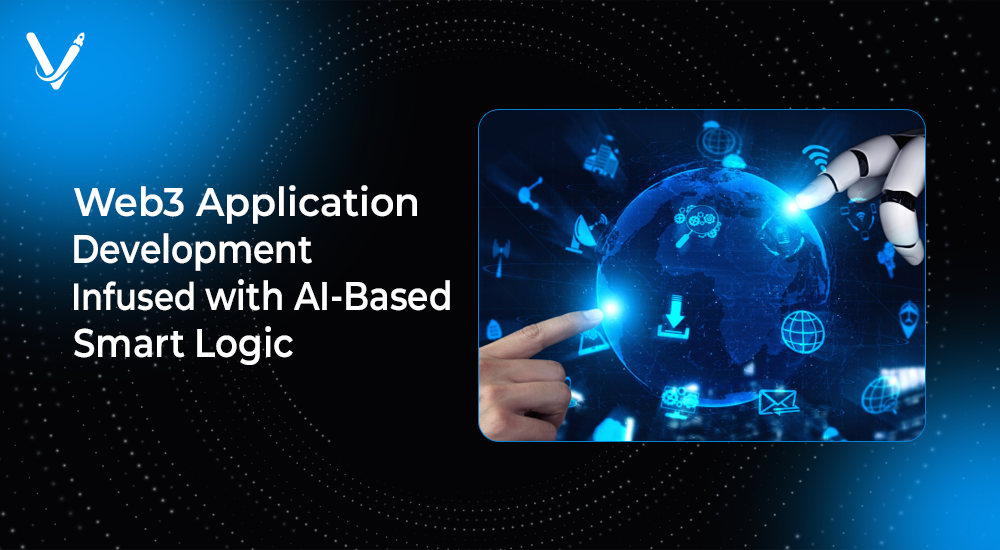Web3 Application Development Infused with AI-Based Smart Logic


- Oct 10, 2025



Key Takeaways
The internet is undergoing its most profound evolution yet. The transition from static Web 1.0 to interactive Web 2.0 reshaped how people connect and create. Now, Web3, the decentralized, trustless layer powered by blockchain, introduces a new paradigm of ownership, autonomy, and transparency. But decentralization alone isn’t enough. To reach its full potential, it needs intelligence, the ability to analyze, learn, and act. That’s where AI-based smart logic enters the stage.
When artificial intelligence and Web3 merge, we witness the birth of self-learning, autonomous, and adaptive decentralized systems. Imagine smart contracts that evolve with user behavior, decentralized marketplaces that predict demand, or token economies that self-balance based on community dynamics. This isn’t distant speculation; it’s the direction innovation is already heading.
In this article, we’ll explore how AI-infused Web3 application development is revolutionizing industries, what architectures make this possible, and why the future belongs to intelligent decentralization.
Web3 is often misunderstood as just another blockchain iteration or crypto trend. In reality, it’s the next generation of the internet, built on three fundamental principles: decentralization, transparency, and user sovereignty.
In the Web2 era, power and data were concentrated in centralized entities, tech giants controlling user information, algorithms, and digital infrastructure. Web3 changes that narrative by distributing data across decentralized ledgers and giving users control over their digital identities.
Core technologies shaping this evolution include:
These components make Web3 resilient and open. Yet, they lack intelligence by default. Traditional smart contracts, for instance, can only execute predefined conditions; they cannot adapt, reason, or optimize decisions.
This is where AI-based smart logic becomes the missing link, bridging computational autonomy with data-driven intelligence.
AI-based smart logic transforms Web3 from a rule-based system into a cognitive ecosystem. It allows decentralized apps (dApps) to learn from data patterns, predict outcomes, and autonomously optimize their operations.
Smart logic refers to embedded intelligence that drives adaptive behavior in digital systems. In the context of Web3, this means combining the deterministic reliability of blockchain with the probabilistic reasoning of AI.
Traditional smart contracts follow “if-this-then-that” logic. They are rigid, deterministic, and incapable of dynamic adaptation. By infusing AI into the mix, these contracts become “smart agents” that can:
In short, AI empowers Web3 systems to think, learn, and evolve, turning static rules into living, intelligent protocols.
At first glance, AI and blockchain may seem contradictory; AI thrives on data centralization for training, while blockchain promotes decentralization. Yet, they complement each other perfectly when integrated thoughtfully.
Together, these forces form an intelligent digital mesh, where autonomous systems operate on verifiable data without relying on centralized authorities.
Building an intelligent decentralized application requires a multi-layered approach. Below is a conceptual framework of how AI and Web3 coexist harmoniously.
Data forms the foundation of any AI-driven system. In Web3, storage mechanisms like IPFS, Arweave, and Filecoin ensure that information remains tamper-proof and publicly accessible while maintaining integrity. AI models can access this distributed data via encrypted protocols, ensuring compliance with privacy and security standards.
Here lies the intelligence. Smart contracts govern core logic on-chain, while off-chain AI engines handle advanced computation, training models, running predictions, and feeding outcomes back into the blockchain via oracles.
This hybrid architecture (on-chain trust + off-chain intelligence) enables efficient AI integration without sacrificing decentralization.
User-facing decentralized applications (like DeFi dashboards, NFT marketplaces, or DAOs) harness insights generated by AI. For example, AI can recommend governance proposals, suggest investment portfolios, or adjust gas fees dynamically.
Decentralized Autonomous Organizations (DAOs) often struggle with decision paralysis and inefficient voting systems. AI-based smart logic can prioritize proposals, summarize debates, and even simulate outcomes before community votes, making governance more informed and efficient.
Together, these layers form the blueprint for Web3 intelligence, where every transaction, decision, and evolution is guided by adaptive learning.
DeFi platforms can employ AI to predict liquidity needs, detect suspicious activities, and optimize yield strategies. Intelligent bots powered by machine learning continuously analyze market data to rebalance portfolios or prevent flash loan exploits, making financial ecosystems safer and smarter.
Traditional NFTs are static collectibles. With AI, they become evolving digital entities that adapt over time. Imagine a digital artwork that changes based on global events, or a gaming NFT character that learns from player interactions. AI injects life into digital ownership.
DAOs face the challenge of managing diverse opinions across thousands of members. AI algorithms can analyze historical voting trends, simulate proposal outcomes, and recommend governance adjustments, helping DAOs stay agile and effective.
AI can enhance decentralized identity frameworks by providing behavior-based reputation scoring. This empowers Web3 communities to assess trustworthiness without revealing private data, balancing anonymity and accountability.
Blockchain ensures traceability, while AI predicts disruptions, delays, or fraudulent activities. When combined, they create intelligent supply networks that are transparent, predictive, and resilient to global shocks.
Despite its transformative promise, the fusion of AI and Web3 faces notable challenges. Understanding these hurdles is crucial for innovators and investors aiming to build sustainable ecosystems.
Blockchain networks, especially public ones, are resource-limited. Executing AI algorithms directly on-chain is impractical due to high gas costs and slow processing times. The solution lies in off-chain computation frameworks and layer-2 scaling solutions that handle AI workloads efficiently.
AI thrives on large datasets, but decentralized systems prioritize user privacy. Striking the balance requires privacy-preserving AI techniques such as federated learning and zero-knowledge proofs, which enable training without exposing sensitive data.
Ensuring transparency in AI decision-making is vital. Combining verifiable computation protocols with blockchain audit trails allows communities to inspect how AI models reach conclusions, reducing bias and enhancing accountability.
For AI-based smart logic to thrive, seamless communication between multiple blockchains and data oracles is essential. Cross-chain interoperability protocols like Polkadot, Cosmos, and Chainlink CCIP play a pivotal role in bridging ecosystems.
AI introduces complexity in accountability: who is responsible when an autonomous smart contract makes a costly error? Addressing this requires new legal frameworks and ethical standards that align with decentralized governance principles.
For visionary founders and investors, the convergence of AI and Web3 represents an unprecedented frontier of opportunity. It’s not just about building new technology,it’s about redefining how digital economies function.
AI-powered smart contracts can automate decision-making and reduce reliance on manual oversight. This leads to cost savings, faster execution, and minimal human error across industries, from finance to real estate.
AI personalization within decentralized ecosystems ensures that users get relevant recommendations, insights, and outcomes without compromising data privacy. Businesses can build trust-based personalization, something nearly impossible in centralized environments.
For investors, AI-powered Web3 platforms offer real-time analytics on portfolio performance, DAO voting patterns, and community sentiment. Predictive AI tools can identify high-potential tokens or projects before they surge in popularity.
AI can stabilize token economies by analyzing user participation, liquidity flows, and governance engagement, ensuring long-term ecosystem health. Investors benefit from dynamic, self-regulating markets that reduce volatility.
Companies adopting AI-driven Web3 applications signal innovation leadership. Early movers in this convergence will shape industry standards, attract top talent, and secure early network effects that amplify growth.
The synergy between Web3 and AI is not confined to tech enthusiasts, it’s rapidly influencing real-world sectors:
AI-enhanced DeFi platforms now predict lending risks, automate collateral adjustments, and enhance fraud detection, making decentralized finance more stable and investor-friendly.
Decentralized AI systems protect patient data while enabling collaborative research across borders. Smart logic automates compliance with regulations like HIPAA without exposing sensitive data.
AI-driven NPCs (non-player characters) evolve based on blockchain events, while decentralized economies ensure players retain ownership of digital assets. The result is a living metaverse powered by collective intelligence.
AI analyzes blockchain-verified logistics data to forecast delays, optimize inventory, and prevent counterfeiting. This ensures global supply chains operate with trust and transparency.
Smart contracts automate lease agreements, AI predicts property value fluctuations, and decentralized registries ensure transparent ownership, creating a secure, intelligent property ecosystem.
The development stack behind AI-infused Web3 applications continues to evolve, blending decentralized infrastructure with intelligent computation.
This combination allows developers to create AI-powered dApps that are transparent, scalable, and adaptive, unlocking the next phase of digital transformation.
The next decade will witness the rise of self-sustaining, intelligent economies powered by AI-augmented Web3 systems. These ecosystems won’t just facilitate transactions; they will analyze, predict, and self-optimize in real time.
Imagine DAOs that evolve like living organisms, token economies that self-balance based on community participation, and decentralized AI marketplaces that trade algorithms as digital assets.
As quantum computing and advanced cryptography mature, the boundary between computation and cognition will blur further, paving the way for conscious decentralized networks,systems that don’t just process data but understand intent.
Businesses that align early with this evolution will lead the future of digital sovereignty, automation, and trust.
The convergence of Web3 application development and AI-based smart logic is more than a technological milestone; it’s a philosophical shift toward an intelligent, transparent, and human-centric internet.
For founders and investors, this fusion opens a gateway to autonomous ecosystems that scale sustainably, reduce operational friction, and deliver deep personalization without compromising privacy.
As enterprises look toward the next wave of digital transformation, the message is clear: Intelligence must be decentralized, and decentralization must be intelligent.
At Vasundhara Infotech, we specialize in building future-ready Web3 ecosystems infused with AI-driven smart logic, designed to empower innovation, scalability, and user trust. Whether you’re conceptualizing a DeFi platform, an AI-powered DAO, or a next-gen metaverse economy, our team transforms visionary ideas into functional, intelligent applications.
Ready to build the next intelligent decentralized system?
Connect with us today and unlock the future of smart Web3 innovation.
Copyright © 2025 Vasundhara Infotech. All Rights Reserved.